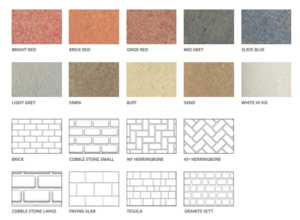FAQ
Frequently Ask Questions
Featured
Most popular questions
TexturePrint is a hot-applied wearing course consisting of blended thermoplastic polymerised resins, plasticiser, graded granite aggregate, selected fillers and pigment. It is surface dressed with either sand or glass beads prior to being embossed with a patterned grid tool.
TexturePrint is manufactured in a wide range of colours and textures for specialist installation.
Pigment is fully dispersed throughout the material.
TexturePrint is a highly adaptable system, with numerous pattern/ colour combinations. The finished surface is design to mimic the appearance of traditional brick setts, cobbles, paving or flags, without the associated maintenance costs.
TexturePrint material can be customised to individually address the needs of different environments.
For our full range of design options, please get in touch with us here.
TexturePrint can be applied to concrete, bituminous and most other substrates providing they are in a stable condition.
Typical uses include:
- Traffic calming schemes
- Raised junctions, central reservations, speed tables & roundabouts
- Home zones and urban regeneration projects
- Parking bays
- Crossing points
- Urban landscaping
Choosing TexturePrint can help you eliminate 3 potential pitfalls.
- Unstable substrate: a new surface is only as good as what’s underneath. TexturePrint can be applied to concrete, bituminous and most other substrates providing they are in a stable condition to begin with.
- Old formulation: unlike competing products, TexturePrint’s unique formulation is continually adapted to stay ahead of raw material changes to make sure it always performs.
- Poor application: Our experienced installation staff are specialists at what they do, and have the backing of TexturePrint as the manufacturer of TexturePrint.
Prior to installation of TexturePrint, the underlying surface must be free from any old residue, dust or small/large objects that could interfere with performance. The surface should be in a stable and sound condition.
- Our crew generally cleans the entire surface with hot compressed air and gas before applying the material at a 15mm standard thickness to the wearing course.
- It takes about one hour for the meltable polyethylene bags to be mixed to an adequate bonding and colour uniformity. This heating process starts the moment our crew arrives at its destination. There are two pre-heated tanks that our crew uses and they are located in the end of the wagon.
- The thermoplastic solution is spread evenly onto the surface, the approved design pattern is stamped to a depth of 5-7mm. TexturePrint is suitable for use in areas where vehicles are expected to drive and performs exceptionally well even when subject to heavy wear.
- Excellent long term cost effectiveness
- Very low maintenance (including no growth of weeds or vegetation)
- No excavation necessary – fast installation & curing times
- Laid at 15mm thickness – our material is flexible and durable enough to support heavy traffic
- High skid resistance for improved safety
- Through colour – fully pigmented throughout the surfacing
- UV stable colour range
- Improved safety over traditional paved surfaces
- Wide range of design applications
- No trip hazards
- Can be reflectorized for enhanced visibility (white only)
TexturePrint is a highly adaptable system, with almost limitless pattern and colour combinations.
Full dispersing the pigment throughout the material creates a uniform solution that lasts longer than traditional applications. Textureprint’s durability means it is resistant to weather conditions and abrasion from traffic. You will not need to worry about extra coatings and repeated maintenance visits.
The TexturePrint standard range of patterns and colours is set out below. For custom colours (including colour matching) and bespoke patterns please get in touch.

There is no need to excavate or set cement as TexturePrint can be applied directly to most stable substrates.
As TexturePrint moulds to the surface underneath it will reflect the imperfections of the underlying layer if it is cracked or severely damaged.
To ensure the longevity of a TexturePrint surface it must be applied to a smooth and sound underlayer.

